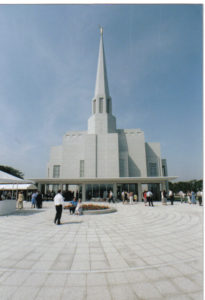
Preston Temple
Only Latter-day Saints baptize living people on behalf of the dead. The LDS maintain that temple baptism for the dead is endorsed by the Scriptures and was part of the original Christian faith as established two thousand years ago. However, a study of Christian antiquities reveals that baptism for the dead was not practised by the first followers of Jesus, and had a very different meaning from that given to it by Mormons.
Was it really ever part of the historic Christian faith that living people be baptized on behalf of the dead? The Scripture passage Mormons cite for support of their practice is 1 Corinthians 15.29:
Else what shall they do which are baptized for the dead, if the dead rise not at all? why are they then baptized for the dead? (KJV)
The concept is not mentioned elsewhere in the Bible or in other early Christian documents, with two exceptions. If it had been as important or as frequent a part of the original Gospel as it is to one of our latter-day denominations, we would expect to find many references to it in writings by Christians who lived a short time after Jesus. Yet, barring one reference by Clement of Alexandria in Excerpt 22 of Excerpta ex Theodoto and one by Tertullian in Against Marcion 5.10, 1 Corinthians 15.29 stands alone in the age of Saint Paul and for centuries afterwards.
Clement of Alexandria
Clement of Alexandria lived from about AD 153 to 217. A native of Greece, he travelled and studied widely before settling in Egypt. Here, in the AD 190s, he was the principal or dean of Christianity’s foremost theological school and one of the most prominent Christian teachers of his age. He was well versed in the science of the day, in philosophy and in religion, including Christian sects. Among his writings against deviations from Christianity he mentioned baptism for the dead as a tenet of a particular Gnostic sect.
‘Gnostic’ meant a person who claimed to possess a secret religious knowledge. The Gnostics were a strange species of Christians, if they were Christians at all. They believed that only the spirit is good and pleasing to God and that all matter is evil and death. The very origin of matter was evil and not from God.
The Gnostic group encountered in the Excerpta ex Theodoto was that of one Theodotus, who taught that there were an original divine mother and father who gave birth to other spirit beings. Rebellious and envious, their youngest great-granddaughter attempted to imitate their action of producing spirit children.
She did such a bad job that in addition to (good) soul and spirit she gave birth to (evil) matter. Her action created a separation from the first divine parents. Moreover, in some instances matter and spirit were mixed in such a way that particles of soul and spirit were trapped in material human bodies.
Other particles of spirit escaped and continued in the purely spiritual form of angels. In order to liberate themselves from their bodily prisons of flesh and death to be reunited with the first parents (be saved), members of Theodotus’ sect relied on absorbing a body of secret knowledge about angels, gods, and other spirit beings including what was referred to as ‘baptism for the dead’.
Clement’s Excerpta ex Theodoto relates that Theodotus’ Gnostics believed that the ones who are baptized in 1 Corinthians 15 are angels, spirit creatures who had escaped imprisonment in matter. Only pure spirit beings are truly alive, and the redemption process can begin only with them. The ones for whom they are baptized are human beings, whom Theodotus’ group considered to be dead due to being trapped in bodies of flesh.
An angel must first be baptized in heaven on behalf of a ‘dead’ human, followed by the human’s own baptism on earth. Being prisoners of the flesh and the material world and dead to the spiritual, humans cannot start the process. According to Clement, 1 Corinthians 15.29 refers to this Gnostic concept. Neither Paul, Clement, nor the Gnostics taught that humans still in material bodies were baptized for deceased humans.
To Theodotus’ Gnostics, ‘resurrection’ meant that the soul is freed from the body and raised up to equality with the angels in a purely spiritual world, a world of true life with the original divine spirit parents. Note also that one of the main themes in 1 Corinthians 15 is the resurrection and incorrect views about it. It is not a discussion about baptism.
It does touch on baptism for the dead but only secondarily to the resurrection of our material bodies; Paul mentions baptism for the dead only as part of an argument against the Gnostics’ eccentric notions about the resurrection, in order to turn their theories against them.
The strange dogmas described in Excerpta ex Theodoto were based on the secret knowledge Gnostics claimed they alone possessed. Paul’s warning in 1 Timothy 6.20 against ‘what is falsely called knowledge’ (RSV) indicates that the Apostle both knew about and opposed Gnosticism, including the idea of angelic baptism for the spiritually dead and other Gnostic tenets described by Clement 150 years later.
Paul’s counsel in 1 Timothy 1.4 and Titus 3.9 to avoid ‘endless genealogies’ remind us of the Gnostics’ lines of descent from the original spirit parents to their great-granddaughter, humans and angels. He also recalls to our memories the unstinting genealogical research of modern-day practitioners of their misinterpretation of baptism for the dead.
Briefly, what 1 Corinthians 15.29 refers to is this Gnostic concept. Neither Paul nor the Gnostics taught that humans still in material bodies were baptized for deceased humans. Note that 1 Corinthians 15.29 does not ask ‘what shall we do which are baptized for the dead’ but rather ‘what shall they do’. The Excerpta ex Theodoto indicates that ‘they’ are the angels, not Christians on earth. Such ‘baptism for the dead’ was not a standard or apostolic Christian doctrine but a Gnostic one, which Paul and Clement used against these heretics.
Tertullian
We now turn to the evidence of Tertullian’s Against Marcion that there was an another aberrant Christian sect that believed in baptism for the dead. This book was written sometime between AD 207 and 232 by a prominent lawyer who had converted to Christianity and became a Christian clergyman.
Tertullian wrote against many heresies, including that of the Marcionites. Their founder, Marcion, and his followers shared many beliefs with the Gnostics, including that matter was evil and only the spirit was good. However they did not believe in the great number and genealogies of gods propounded by the Gnostics. Nevertheless, Marcionites did believe in more than one deity.
Like the Gnostics and Mormons, Marcion’s interpretations of the Christian faith were regarded by mainstream Chrtistians as fanciful and perverted. He even sought to abolish the Bible of the church and introduce his own in its place.
Irenaus
Marcion’s ideas were so close to the Gnostics that the church father Irenaeus in the AD 180s regarded him as one of them. Because we know so little about the rites and sacramental practices of the Marcionites and the Gnostics, and given the similarities between them, we must conclude that their reasons were similar, because they shared the doctrine of baptism for the dead.
Because Marcion was not active until the middle of the second century, born much too late to have been at Corinth in the time of Saint Paul, we must conclude that Marcion adopted the concept of baptism for the dead from them, who (as we have seen) were there in Paul’s time.
In any event, the testimonies of the Apostle Paul and of the church fathers Irenaeus, Clement of Alexandria, and Tertullian are unanimous that this practice was not that of the standard, right-thinking, majority church but was beyond the pale of the Christianity taught by Jesus and His disciples.
Joseph Smith
The origins of baptism for the dead in the LDS sense, temple baptism, cannot be traced further back than Doctrine and Covenants Section 124 in 1841 and Doctrine and Covenants Section 128 (1842), the first of which says it is a revelation of God to Joseph Smith Jr. Regarded by Latter-day Saints as possessing authority equal to the Bible, Doctrine and Covenants stipulates that baptism on behalf of the non-Mormon deceased can be performed only in Mormon temples, or is otherwise of no effect.
Section 128.11-18 teach that immersion for the dead is no light duty for living members of the Church of Jesus Christ of Latter-day Saints, and involves the salvation of both the living and the dead. The salvation of deceased ancestors through temple baptism is essential for that of living Mormons because, by immutable celestial design, they cannot be saved unless their ancestors are also (Sec. 128.15 and 18).
Being saved, or exalted in heaven, is by family units, stretching back for generations, and no-one attains it without including previous members of their families by being baptized on their behalf. Mormon family values are not altruistic: a person cannot see heaven unless his lineal relatives do also.
In addition to 1 Corinthians 15.29, Mormons quote Malachi 4.5-6. The last two verses of the Old Testament prophesy that in the last days God will turn the hearts of the fathers to their children and vice versa. Latter-day Saints interpret this to be evidence of the grand celestial design by which LDS families and their ancestors will be sealed and bound together in heaven, beginning by the baptism of the living on behalf of the dead progenitors.
However, in its original historical and Biblical context, and in the sense of the phrase as understood by the earliest Christians, baptism for the dead meant something radically different from Mormon theology and practice.
In early Christianity it was distinctive of fringe cults opposed by mainline Christians and, even so, was probably never practiced by or on human beings. As the first heirs of the Apostle Paul, Clement and the other orthodox authors shared the Apostle’s culture and language to an extent that they knew the background of his writings and how he meant them to be understood.
An interpreter loses these advantages, and thereby the meaning of Paul’s statements, if s/he works only in the milieus of the nineteenth or twenty-first centuries.
References
Clement of Alexandria, Saint (ca. AD 153 to 217)
The Excerpta ex Theodoto, edited with translation, introduction and notes by Robert Pierce Casey (London: Christophers, 1934) Series: Studies and Documents, vol. 1
Clement of Alexandria, Saint (ca. AD 153 to 217)
Extraits de Théodote: texte grec, introduction, traduction et notes de François Sagnard (Paris: Cerf, 1970) Series: Sources chrétiennes no. 23
Doctrine and Covenants 124 (AD 1841)
Doctrine and Covenants 128 (AD 1842)
Irenaeus Against Heresies 1.27.1-2, 4 in The Ante-Nicene Fathers; Translations of The Writings of the Fathers down to A.D. 325, edited by Alexander Roberts and James Donaldson. American reprint ed. by A. Cleveland Coxe (Buffalo, NY: Christian Literature Publishing Co., 1885-96; reprinted Grand Rapids, Mich.: Wm. B. Eerdmans, 1985) vol. 1 pp. 352f.
Karen L. King ‘Valentinus’ in Encyclopedia of Early Christianity, edited by Everett Ferguson (New York: Garland, 1990)
Robert Rea ‘Theodotus’ in Encyclopedia of Early Christianity, edited by Everett Ferguson (New York: Garland, 1990)
Hendrik F. Stander ‘Marcion’ in Encyclopedia of Early Christianity, edited by Everett Ferguson (New York: Garland, 1990)
Tertullian Against Marcion 5.10 in The Ante-Nicene Fathers; Translations of The Writings of the Fathers down to A.D. 325, edited by Alexander Roberts and James Donaldson. American reprint ed. by A. Cleveland Coxe (Buffalo, NY: Christian Literature Publishing Co., 1885-96; reprinted Grand Rapids, Mich.: Wm. B. Eerdmans, 1986) vol. 3 pp. 449f.
Copyright © 2006, 2011 David W. T. Brattston, Lunenburg, Nova Scotia, Canada. Used with permission.

